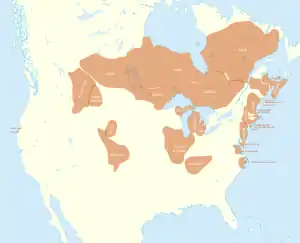Algic languages
The Algic (also Algonquian–Wiyot–Yurok or Algonquian–Ritwan)[1][2] languages are an indigenous language family of North America. Most Algic languages belong to the Algonquian subfamily, dispersed over a broad area from the Rocky Mountains to Atlantic Canada. The other Algic languages are the Yurok and Wiyot of northwestern California, which, despite their geographic proximity, are not closely related. All these languages descend from Proto-Algic, a second-order proto-language estimated to have been spoken about 7,000 years ago and reconstructed using the reconstructed Proto-Algonquian language and the Wiyot and Yurok languages.

| Algic | |
|---|---|
| Algonquian–Ritwan | |
| Geographic distribution | northern North America |
| Linguistic classification | One of the world's primary language families |
| Proto-language | Proto-Algic |
| Subdivisions | |
| ISO 639-5 | aql |
| Glottolog | algi1248 |
 Pre-contact distribution of Algic languages | |
| Notes | † - extinct language |
History
The term "Algic" was first coined by Henry Schoolcraft in his Algic Researches, published in 1839. Schoolcraft defined the term as "derived from the words Allegheny and Atlantic, in reference to the indigenous people anciently located in this geographical area."[3] Schoolcraft's terminology was not retained. The peoples he called "Algic" were later included among the speakers of Algonquian languages. This language group is also referred to as "Algonquian-Ritwan" and "Wiyot-Yurok-Algonquian"
When Edward Sapir proposed that the well-established Algonquian family was genetically related to the Wiyot and Yurok languages of northern California, he applied the term Algic to this larger family. The Algic urheimat is thought to have been located in the Northwestern United States somewhere between the suspected homeland of the Algonquian branch (to the west of Lake Superior according to Goddard[4]) and the earliest known location of the Wiyot and Yurok (along the middle Columbia River according to Whistler[5]).
Classification of Algic
The genetic relation of Wiyot and Yurok to Algonquian was first proposed by Edward Sapir (1913, 1915, 1923), and argued against by Algonquianist Truman Michelson (1914, 1914, 1935). According to Lyle Campbell (1997), the relationship "has subsequently been demonstrated to the satisfaction of all".[6] This controversy in the early classification of North American languages was called the "Ritwan controversy" because Wiyot and Yurok were assigned to a genetic grouping called "Ritwan". Most specialists now reject the validity of the Ritwan genetic node.[7] Berman (1982) suggested that Wiyot and Yurok share sound changes not shared by the rest of Algic (which would be explainable by either areal diffusion or genetic relatedness); Proulx (2004) argued against Berman's conclusion of common sound changes.
More recently, Sergei Nikolaev has argued in two papers for a systematic relationship between the Nivkh language of Sakhalin and the Amur river basin and the Algic languages, and a secondary relationship between these two together and the Wakashan languages.[8][9]
Proto-language
See also
Notes
- Berman, Howard (July 1984). "Proto-Algonquian-Ritwan Verbal Roots". International Journal of American Linguistics. 50 (3): 335–342. doi:10.1086/465840. ISSN 0020-7071. S2CID 144285942.
- Golla, Victor (September 20, 2011). California Indian languages. Berkeley. p. 61. ISBN 9780520949522. OCLC 755008853.
- Schoolcraft 1839:12
- Goddard 1994:207
- Moratto 1984:540, 546, 564
- Campbell 2000, p. 152, who cites among others Haas 1958
- Campbell 2000, p. 152; Mithun 1999, p. 337
- Nikolaev 2015.
- Nikolaev 2016.
Bibliography
Journals and books
- Berman, Howard (1982). "Two Phonological Innovations in Ritwan". International Journal of American Linguistics. 48 (4): 412–420. doi:10.1086/465750. ISSN 0020-7071. S2CID 144518292.
- Campbell, Lyle (September 21, 2000) [1997]. American Indian Languages: The Historical Linguistics of Native America. New York: Oxford University Press. ISBN 978-0-19-509427-5.
- Goddard, Ives (1994). Cowan, William (ed.). "The West-to-East cline in Algonquian dialectology". Actes du Vingt-cinquième Congrès des Algonquinistes. 25. hdl:10088/21761. Retrieved December 1, 2018.
- Goddard, Ives (1996). "Languages". In Sturtevant, W. C. (ed.). Handbook of North American Indians. 17. Washington, D. C.: Smithsonian Institution. ISBN 978-0-16-048774-3.
- Haas, Mary R. (1958). "Algonkian-Ritwan: The End of a Controversy". International Journal of American Linguistics. 24 (3): 159–173. doi:10.1086/464453. ISSN 0020-7071. S2CID 143214234.
- Haas, Mary R. (1966). "Wiyot-Yurok-Algonkian and Problems of Comparative Algonkian". International Journal of American Linguistics. 32 (2): 101–107. doi:10.1086/464889. ISSN 0020-7071. S2CID 144355911.
- Michelson, Truman (1914). "Two Alleged Algonquian Languages of California". American Anthropologist. 16 (2): 361–367. doi:10.1525/aa.1914.16.2.02a00150. ISSN 0002-7294.
- Michelson, Truman. 1915. Rejoinder. American Anthropologist, n.s. 17:194–198.
- Michelson, Truman (1935). "Phonetic Shifts in Algonquian Languages". International Journal of American Linguistics. 8 (3/4): 131–171. doi:10.1086/463813. ISSN 0020-7071. S2CID 143895922.
- Mithun, Marianne (1999). The languages of Native North America. Cambridge: Cambridge University Press. ISBN 978-0-521-23228-9. (hbk); ISBN 0-521-29875-X.
- Moratto, Michael J. (1984). California archaeology. Academic Press.
- Nikolaev, Sergei L. (2015). "Toward the reconstruction of Proto-Algonquian-Wakashan. Part 1: Proof of the Algonquian-Wakashan relationship". Journal of Language Relationship. 13 (1): 23–61. doi:10.31826/jlr-2015-131-206. S2CID 212688261. Retrieved December 1, 2018.
- Nikolaev, Sergei L. (2016). "Toward the reconstruction of Proto-Algonquian-Wakashan. Part 2: Algonquian-Wakashan sound correspondences". Journal of Language Relationship. 13 (4): 289–328. doi:10.31826/jlr-2016-133-408. S2CID 212688688. Retrieved December 1, 2018.
- Proulx, Paul (1982). "Yurok Retroflection and Vowel Symbolism in Proto-Algic". Kansas Working Papers in Linguistics. 7: 119–123. doi:10.17161/KWPL.1808.3621. hdl:1808/3621. ISSN 1043-3805.
- Proulx, Paul (1984). "Proto-Algic I: Phonological Sketch". International Journal of American Linguistics. 50 (2): 165–207. doi:10.1086/465826. ISSN 0020-7071. S2CID 144185501.
- Proulx, Paul (1985). "Proto-Algic II: Verbs". International Journal of American Linguistics. 51 (1): 59–93. doi:10.1086/465860. ISSN 0020-7071. S2CID 143787643.
- Proulx, Paul (1991). "Proto-Algic III: Pronouns". Kansas Working Papers in Linguistics. 16: 129–170. doi:10.17161/KWPL.1808.429. hdl:1808/429. ISSN 1043-3805.
- Proulx, Paul (1992). "Proto-Algic IV: Nouns". Kansas Working Papers in Linguistics. 17: 11–57. doi:10.17161/KWPL.1808.644. hdl:1808/644. ISSN 1043-3805.
- Proulx, Paul (1994). "Proto-Algic V: Doublets and their Implications". Kansas Working Papers in Linguistics. 19 (2): 115–182. doi:10.17161/KWPL.1808.321. hdl:1808/321. ISSN 1043-3805.
- Proulx, Paul (2004). "Proto Algic VI: Conditioned Yurok Reflexes of Proto Algic Vowels". Kansas Working Papers in Linguistics. 27: 124–138. doi:10.17161/KWPL.1808.1247. hdl:1808/1247. ISSN 1043-3805.
- Sturtevant, William C., ed. (1978). Handbook of North American Indians. 1–20. Washington, D. C.: Smithsonian Institution.
- Sapir, Edward (1913). "Wiyot and Yurok, Algonkin languages of California". American Anthropologist. 15 (4): 617–646. doi:10.1525/aa.1913.15.4.02a00040. ISSN 0002-7294.
- Sapir, E. (1922). "Algonkin languages of California: A reply". American Anthropologist. 17 (1): 188–198. doi:10.1525/aa.1915.17.1.02a00270. ISSN 0002-7294.
- Sapir, Edward (1922). "The Algonkin affinity of Yurok and Wiyot kinship terms". Journal de la Société des Américanistes. 14 (1): 36–74. doi:10.3406/jsa.1922.3991. hdl:1974/11913. ISSN 0037-9174.
- Schoolcraft, Henry Rowe (1839). Algic researches, comprising inquiries respecting the mental characteristics of the North American Indians. First series. Indian tales and legends. 1. New York: Harper & Brothers. OCLC 6836253. OL 17492450M.